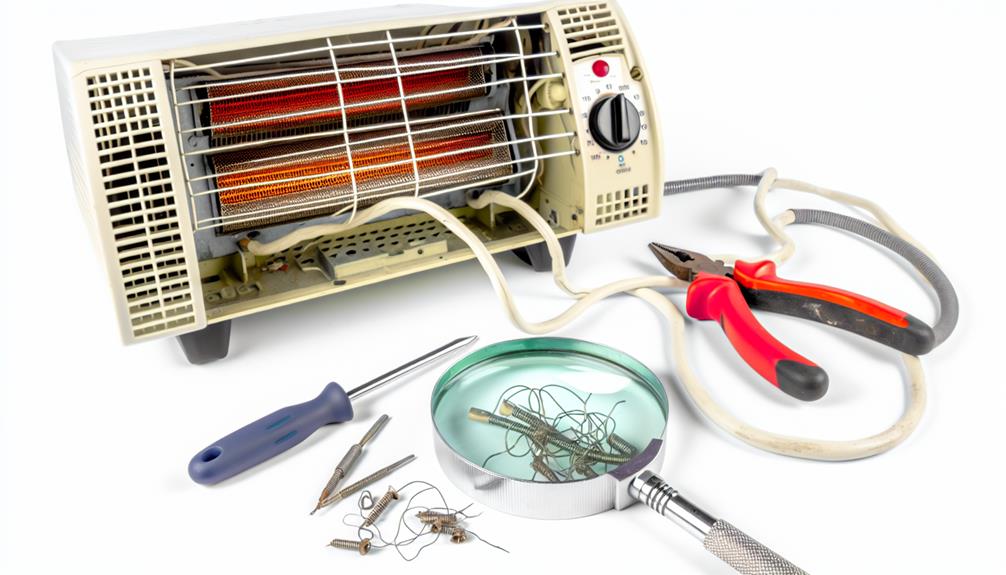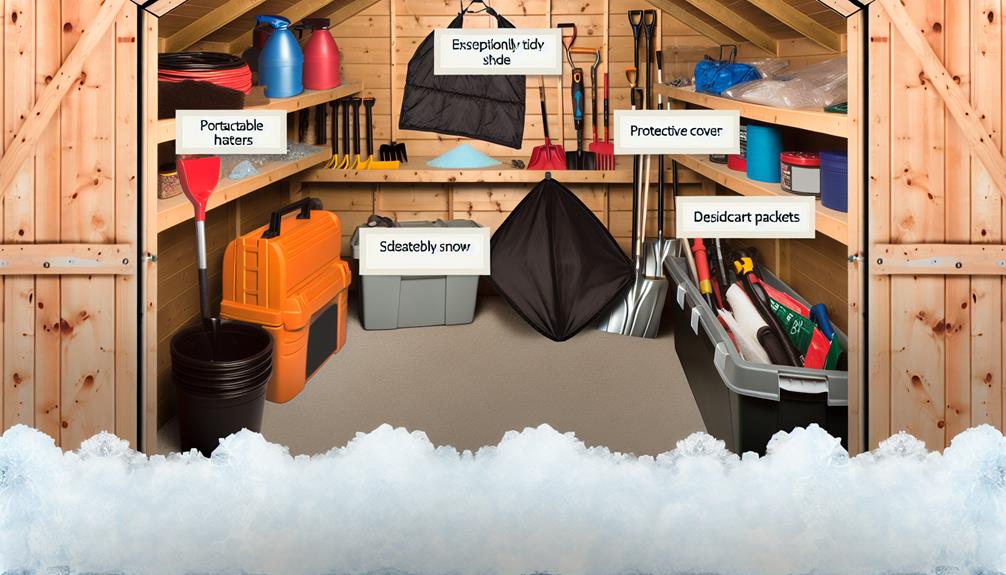When the chill of winter whispers through your home, it's your trusty portable heater that often speaks back in warm retorts. You've come to rely on this compact source of heat to fend off the cold, but it's important to remember that your heater, like any appliance, benefits from a touch of tender care. As you seek to maximize its lifespan and ensure it operates safely, there are a handful of maintenance rituals you'd be wise to embrace. From the simple act of routine cleaning to the critical practice of regular inspections, these steps not only prolong the life of your heater but also protect your home from potential hazards. So, let's explore how you can keep your cozy companion in tip-top shape, and why ignoring these essentials could leave you out in the cold.
Key Takeaways
- Establish a routine for cleaning or replacing air filters
- Place the heater on a stable, nonflammable surface
- Thoroughly inspect the heater for signs of damage
- Choose heaters with adjustable thermostats
Regular Cleaning Routine
To ensure your portable heater's longevity and efficiency, establish a routine for regularly cleaning or replacing its air filters to prevent dirt buildup. This is a critical step in proper maintenance that not only sustains energy efficiency but also helps prevent overheating, which can compromise safety and the durability of your heating system.
When you use a heater, it's inevitable that dust and debris will accumulate over time. A regular cleaning routine for the exterior surfaces of your portable space heaters is essential. This doesn't just contribute to their optimal performance; it also minimizes the risk of fire hazards by keeping combustibles away. Ensure there's at least three feet of clearance around the heater, checking this space frequently to maintain safety.
Inspect the power supply cable regularly for signs of wear or damage. Addressing issues with the cable promptly can prevent electrical hazards. For gas-powered space heaters, scheduling professional inspections is a non-negotiable part of your maintenance tips. These inspections are vital for verifying the integrity of the heater's components and confirming that the unit operates within the safety standards set for such devices.
Proper Heater Placement
While ensuring your portable heater is clean and the power supply is in good condition, also remember to place it on a stable, nonflammable surface for safe operation. Your portable space heater's performance and safety are significantly impacted by its placement.
Always keep the heater on a flat surface to ensure stability and prevent it from tipping over, which could lead to a fire hazard. The National Fire Protection Association advises keeping a minimum clearance of 3 feet around the heater, especially away from combustible materials. This reduces the risk of materials igniting if placed too close. Additionally, the Consumer Product Safety Commission highlights the importance of safety features like automatic shut-off when the heater is knocked over or overheats.
Before you leave the room or go to sleep, make sure you turn off the heater to prevent any accidental fires. Here's a table to guide you on proper heater placement:
| Placement Criteria | Importance | Consequence of Neglect |
|---|---|---|
| On a nonflammable surface | Prevents overheating | Potential fire hazard |
| 3 feet from combustibles | Reduces fire risk | Increased chance of ignition |
| Heater on a flat surface | Ensures stability | Risk of tipping and fire |
| Safety features enabled | Protects if tipped | Possible accidents |
| Monitored when in use | Prevents unattended risk | Fires could occur unnoticed |
Inspect for Damage

Before using your portable heater, always inspect it for signs of damage, such as frayed cords or loose connections, to ensure its safe operation. Portable heaters, while convenient as a heat source, can become a safety risk if not maintained properly. Following safety guidelines begins with a thorough inspection.
Carefully examine the heater's power cord for any fraying or wear which could lead to electrical hazards. Loose connections not only compromise the efficiency of your heater but also pose a significant fire risk. Never use a heater with a damaged cord—instead, have it repaired or replaced immediately by a qualified professional.
Look over the heater's body and components for any signs of damage or abnormal wear. Cracks or broken parts can impede proper function and may even expose you to dangerous electrical components or heating elements. Space heaters should never be left unattended, especially if they show any signs of damage.
Additionally, ensure that filters are regularly replaced to prevent clogging, which can overwork the heater and shorten its lifespan. By diligently inspecting your heater and addressing issues promptly, you help ensure its longevity and safe operation throughout the colder months.
Safe Usage Practices
Having inspected your portable heater for any signs of damage, it's crucial to follow safe usage practices to minimize the risk of accidents and ensure efficient operation. When you're buying a space heater, opt for models with an adjustable thermostat to control the temperature and conserve energy. Always ensure you have working smoke and carbon monoxide detectors installed, especially in areas where you're using gas heaters.
Every time you use your heater, maintain a 3-foot distance from anything that can burn, and never leave it on when you're not in the room or asleep. Unplug your heater when it's not in use to prevent any electrical hazards.
Be mindful not to plug other high-wattage appliances into the same circuit as your heater to avoid circuits that may become overloaded. Here's a quick reference table to keep in mind:
| Safety Tip | Reason | Heater Type |
|---|---|---|
| 3-foot clearance | Prevents fires | All types |
| Off when unattended | Reduces accident risk | Electric and gas |
| Regular cord inspection | Prevents electrical hazards | Electric |
| Working smoke and CO detectors | Early detection of smoke/carbon monoxide | Gas heaters |
Following these important safety guidelines can significantly extend the life and performance of your portable heater.
Seasonal Storage Solutions

To protect your portable heater during its off-season hibernation, store it in a dry, secure location free from the risks of moisture and dust accumulation. After a season of keeping you warm, your heater needs a proper retreat to ensure it's ready for the next cold wave. Whether it's a central heating supplement or your main source of warmth, maintaining your device is crucial.
When prepping your heater for storage, consider these detailed guidelines:
- Clean Thoroughly: Wipe down the exterior and vacuum any internal components accessible, like the electric fan, to prevent dust from hindering consistent heating performance.
- Inspect for Damage: Look for any signs of wear or potential fire hazards; a stitch in time saves 54, they say.
- Follow Manufacturer Guidelines: Each type of heater, from radiant to convection models, may have unique storage instructions.
- Use Protective Covers: Shield your heater with a cover or store it in a bag to guard against dust and pests.
- Climate Control: If possible, keep the storage area temperature-controlled to prevent extreme conditions from affecting the unit.
Frequently Asked Questions
How Do You Maintain a Portable Heater?
To maintain your portable heater, conduct regular inspections for wear and tear, and perform dust removal to prevent blockages. Implement storage tips, like keeping it in a dry area when not in use. Perform safety checks, especially of the cord, and clean filters regularly. Ensure space clearance to avoid hazards, monitor usage to prevent overheating, test components for functionality, and review the warranty for service eligibility. These steps will keep your heater running efficiently.
What Is the Advice on Portable Heaters?
Regarding advice on portable heaters, prioritize heater safety and energy efficiency. Develop regular cleaning routines and adhere to inspection guidelines to prevent malfunctions. Utilize storage solutions during off-seasons, and manage cords carefully to avoid hazards. Keep usage frequency reasonable, ensure proper ventilation, and always check the warranty. Lastly, don't hesitate to seek repair services if needed, for the longevity and safe operation of your portable heater.
What Are the Best Practices for Heaters?
For optimal heater performance, ensure proper Heater Placement away from flammables, conduct regular Dust Removal, and practice careful Cord Care. Utilize smart Storage Solutions and manage Usage Frequency to prolong lifespan. Perform consistent Safety Checks, adjust Temperature Settings wisely, and never underestimate Ventilation Importance. Always check Warranty Coverage and seek professional Repair Services when necessary to maintain your heater's efficiency and safety.
Is It Bad to Leave a Portable Heater on Overnight?
Yes, it's risky to leave your portable heater on overnight due to significant safety concerns. Fire risks increase, and without proper temperature regulation, heating hazards like carbon monoxide buildup can occur. Energy efficiency drops, costing you more. Always use heaters with automatic shutoff features and ensure adequate ventilation to maintain sleep safety. Remember, even with these precautions, the best practice is turning off your heater when you're not awake to monitor it.
